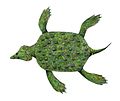Callawayasaurus
Callawayasaurus is a genus of plesiosaur from the family Elasmosauridae. When the holotype was first described by Samuel Paul Welles in 1962,[1] it was described as Alzadasaurus colombiensis before being moved into its current genus by Kenneth Carpenter in 1999.[2] HistoryCallawayasaurus is named in honor of the paleontologist Jack M. Callaway, editor of Ancient Marine Reptiles who, as Carpenter put it, "in his brief career as a vertebrate paleontologist, did much to improve our understanding of marine reptiles."[2] The familiar suffix, -saurus comes from the Greek sauros (σαυρος), meaning "lizard" or "reptile".[3] Description Callawayasaurus was a large plesiosaur, with a skull length of 35 centimetres (1 ft 2 in) and body length of 7.4–8 metres (24–26 ft).[4][5] The nares of Callawayasaurus are elongated and positioned over the maxilla, which has 3-5 teeth.[3] The neck contains 56 vertebrae which are relatively short compared to other elasmosaurids.[3] Callawayasaurus fossils have no pectoral bars; in common with other plesiosaurs such as Terminonatator. They also lack postaxial accessory facets.[6] Another nearly complete skeleton was found to be slightly more robust than the holotype specimen. This subtle change may indicate sexual dimorphism.[3] PaleoenvironmentThe first Callawayasaurus remains were found in the Paja Formation near Leiva, Boyaca Colombia.[3] The specific name for the type, "columbiensis", means "from Colombia".[3] Callawayasaurus are known from the Aptian faunal stage of the early Cretaceous period, which extended from 125 to 112 million years ago.[7] See alsoReferences
External links |
||||||||||||||||||||||||||||||||||
























